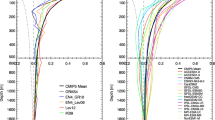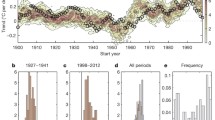Abstract.
Detection of an enhanced greenhouse effect on climate depends on recognition of a signal of change amidst the combined noise of climatic variability and uncertainty in the nature of the signal (functional response to changing CO2). Using two different GCMs (one with a coupled dynamic upper ocean) and an ensemble of 20 equilibrium experiments with CO2 ranging from 100 to 3500 ppm, we find that that two measures of signal-to-noise (S/N) for the response of surface temperature to CO2 forcing are larger over tropical and subtropical oceans than over low-latitude landmasses and larger than at higher latitudes generally. One S/N measure has the noise based solely on inherent model variability, while the other S/N measure includes both this variability and a measure of the uncertainty in the functional nature of the signal. Although the experiments were not for transient forcing and sulphate aerosols and other potentially important forcings (e.g., ozone or solar variability) were not considered, the results suggest that the effects of enhanced greenhouse climate may be detected more readily in surface temperatures from low-latitude oceanic regions than from global or zonal temperature averages.
Similar content being viewed by others

Author information
Authors and Affiliations
Additional information
Received: 27 June 1995/Accepted: 28 October 1996
Rights and permissions
About this article
Cite this article
Syktus, J., Chappell, J., Oglesby, R. et al. Latitudinal dependence of signal-to-noise patterns from two general circulation models with CO2 forcing. Climate Dynamics 13, 293–302 (1997). https://doi.org/10.1007/s003820050167
Issue Date:
DOI: https://doi.org/10.1007/s003820050167



